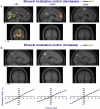A functional neuroimaging study of sound localization: visual cortex activity predicts performance in early-blind individuals
- PMID: 15678166
- PMCID: PMC544927
- DOI: 10.1371/journal.pbio.0030027
A functional neuroimaging study of sound localization: visual cortex activity predicts performance in early-blind individuals
Abstract
Blind individuals often demonstrate enhanced nonvisual perceptual abilities. However, the neural substrate that underlies this improved performance remains to be fully understood. An earlier behavioral study demonstrated that some early-blind people localize sounds more accurately than sighted controls using monaural cues. In order to investigate the neural basis of these behavioral differences in humans, we carried out functional imaging studies using positron emission tomography and a speaker array that permitted pseudo-free-field presentations within the scanner. During binaural sound localization, a sighted control group showed decreased cerebral blood flow in the occipital lobe, which was not seen in early-blind individuals. During monaural sound localization (one ear plugged), the subgroup of early-blind subjects who were behaviorally superior at sound localization displayed two activation foci in the occipital cortex. This effect was not seen in blind persons who did not have superior monaural sound localization abilities, nor in sighted individuals. The degree of activation of one of these foci was strongly correlated with sound localization accuracy across the entire group of blind subjects. The results show that those blind persons who perform better than sighted persons recruit occipital areas to carry out auditory localization under monaural conditions. We therefore conclude that computations carried out in the occipital cortex specifically underlie the enhanced capacity to use monaural cues. Our findings shed light not only on intermodal compensatory mechanisms, but also on individual differences in these mechanisms and on inhibitory patterns that differ between sighted individuals and those deprived of vision early in life.
Figures





References
-
- Niemeyer W, Starlinger I. Do the blind hear better? II Investigations of auditory processing in congenital and early acquired blindness. Audiology. 1981;20:510–515. - PubMed
-
- Muchnick C, Efrati M, Nemeth E, Malin M, Hildesheimer M. Central auditory skills in blind and sighted subjects. Scand Audiol. 1991;20:19–23. - PubMed
-
- Röder B, Gelmuth L, Rösler F. Semantic and morpho-syntactic priming in auditory word recognition in congenitally blind adults. Lang Cogn Processes. 2003;18:1–20.
-
- Bull R, Rathborn H, Clifford BR. The voice recognition accuracy of blind listeners. Perception. 1983;12:223–226. - PubMed
-
- Hull T, Mason H. Performance of blind children on digit-span tests. J Vis Impair Blindn. 1995;89:166–169.
Publication types
MeSH terms
LinkOut - more resources
Full Text Sources
Other Literature Sources
Medical

